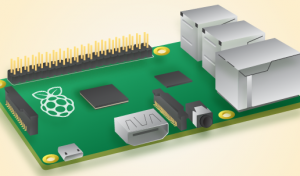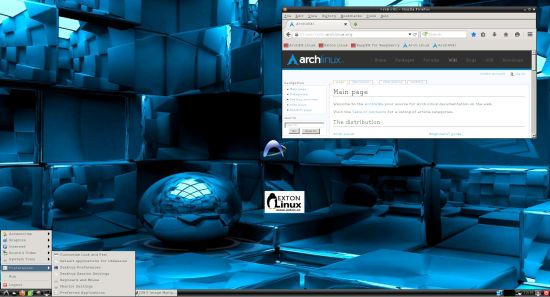 RaspArch is a “remaster” of Arch Linux ARM. The original compressed system is of 231 MB. After I have added the LXDE Desktop environment, Firefox and Gimp the system increased to 665 MB. RaspArch is a “ready-to-go” ARM system. It must be installed on a Raspberry Pi 2 computer.
RaspArch is a “remaster” of Arch Linux ARM. The original compressed system is of 231 MB. After I have added the LXDE Desktop environment, Firefox and Gimp the system increased to 665 MB. RaspArch is a “ready-to-go” ARM system. It must be installed on a Raspberry Pi 2 computer.
What is Raspberry Pi?
The Raspberry Pi is a low cost, credit-card sized computer that plugs into a computer monitor or TV, and uses a standard keyboard and mouse. It is a capable little device that enables people of all ages to explore computing, and to learn how to program in languages like Scratch and Python. It’s capable of doing everything you’d expect a desktop computer to do, from browsing the internet and playing high-definition video, to making spreadsheets, word-processing, and playing games.
Read more about Raspberry Pi…

Raspberry Pi model B made in February 2015. It has a 900MHz quad-core ARM Cortex-A7 CPU and 1GB RAM. Read more…
More about RaspArch
When you have installed RaspArch to your Micro SD Card you can use the system like any other Arch Linux system. I.e. install new programs etc. Arch motto is KISS (Keep It Simple Stupid). RaspArch uses kernel 3.18.11-2-ARCH and the LXDE Desktop environment.
Program Management in Arch Linux
Arch Linux uses a proprietary system called Pacman. It is similar to that found in CRUX Linux. Read about Pacman.
You can also read all the documentation on Arch Linux. Four commands are basically the only ones you need to use:
1) pacman -Sy (update the packages database)
2) pacman -Syu (upgrading the whole system)
3) pacman -S MyUsefulProgram (the package installation command)
4) pacman -R UnnecessaryProgram (uninstall a package).
Very simple!
How do I install RaspArch?
Almost like any other Raspberry system. The installation has to take place in Linux though. (From hard drive or while running a live Linux system from a CD or a USB stick). Follow this instruction. The whole thing has to be done exactly like this.
1. Unpack the downloaded file rasparch-exton-665mb-150414.tar.gz with tar zxvf rasparch-exton-665mb-150414.tar.gz. You will get the folder rasparch-exton. Run the following commands as root. (Do not use Sudo).
2. Start fdisk to partition the SD card:
fdisk /dev/sdd (example; be sure to check which name your SD-card got. I.e. /dev/sdd, /dev/sdc, /dev/sdb or…)
3. At the fdisk prompt, delete old partitions and create a new one:
a. Type o. This will clear out any partitions on the drive.
b. Type p to list partitions. There should be no partitions left.
c. Type n, then p for primary, 1 for the first partition on the drive, press ENTER to accept the default first sector, then type +100M for the last sector.
d. Type t, then c to set the first partition to type W95 FAT32 (LBA).
e. Type n, then p for primary, 2 for the second partition on the drive, and then press ENTER twice to accept the default first and last sector.
f. Write the partition table and exit by typing w.
g. Create and mount the FAT filesystem:
mkfs.vfat /dev/sdd1
mkdir boot
mount /dev/sdd1 boot
4. Create and mount the ext4 filesystem:
mkfs.ext4 /dev/sdd2
mkdir root
mount /dev/sdd2 root
5. cp -av rasparch-exton/* root
6. sync
7. Move boot files to the first partition:
mv root/boot/* boot
8. Unmount the two partitions:
umount boot root
9. Insert the SD card into the Raspberry Pi, connect ethernet, and apply 5V power.
10. You will after a few seconds end up in console mode. Log in as root. The default root password is root. Enter X/LXDE with the command startx
The above instruction (slightly modified) is from the Arch Linux ARM site.

WHO should run Arch Linux?
My answer: The system fits the “advanced” Linux user/enthusiast, who would be willing to run an occasional command from time to time.
BENEFITS of Arch Linux
“Cutting Edge”-software and speed. A member on this site recently wrote this about RaspArch: I’ve used Slackware, Debian, Gentoo, Ubuntu & Arch. I prefer Arch. Ubuntu is easier to install, Arch is easier to keep up to date. You do not go through big, painful, changes every year instead you just update, once in a while, make changes if instructed. Arch has most of the benefits of Gentoo without the pain of recompiling _everything_. When you do need to build a package in Arch its painless especially if you use one of the tools that support Aur (I like yaourt). Arch avoids the politics of Debian and Ubuntu and delivers a great Linux distribution. RaspArch now brings these advantages to the PI 2.
Screenshot of RaspArch’s Desktop
Compatibility :: February 2016
Unfortunately not all systems made for Raspberry Pi 2 will run on the new Pi 3. They need to be upgraded with a new kernel. I therefore have to upgrade the systems I distribute. I.e. RaspEX, RaspEX with OpenCPN, RaspAnd and RaspArch. I have now (160312) upgraded all but RaspAnd. Read about the new Raspberry Pi 3…
DOWNLOAD
This build has been replaced by Build 161205


I’ve used Slackware, Debian, Gentoo, Ubuntu & Arch. I prefer Arch. Ubuntu is easier to install, Arch is easier to keep up to date. You do not go through big, painful, changes every year instead you just update, once in a while, make changes if instructed. Arch has most of the benefits of Gentoo without the pain of recompiling _everything_. When you do need to build a package in Arch its painless especially if you use one of the tools that support Aur (I like yaourt). Arch avoids the politics of Debian and Ubuntu and delivers a great Linux distribution. RaspEX now brings these advantages to the PI 2.
Thanks
Thank you for your clarifying words. May I use them to “advertise” my projects RaspArch and ArchEX?
If you mean my comment – sure.
Hi
This looks interesting. Are you planning on making the installation automated?
–Frazer
LinuxLinks.com
No, it’s quite easy as it is. Or do you mean that you can make a script for it?
RaspArch was mentioned on Linux Today: http://www.linuxtoday.com/infrastructure/rasparch-offers-an-easy-way-to-run-arch-linux-on-raspberry-pi-2-150417212052.html
Pingback: RaspArch: la nuova distro Arch Linux based per il Raspberry Pi 2 | TUXJournal.net
1. make partitions fat,ext4,swap
2. format them mkfs.vfat, mkfs.ext4, mkswap
3. cd /tmp
4. make mount point for root /tmp/rasparch-exton
5. mount root (ext4) to /tmp/rasparch-exton
6. make directory /tmp/rasparch-exton/boot
7. tar xfv rasparch-exton-665mb-150414.tar.gz
8. umount /tmp/rasparch-exton and /boot/tmp/rasparch-exton/boot
Hello, I have tried to follow the command line to get the card ready and transfer files to sd card and have never got it to work. Yesterday I used gparted to make sdc1 and sdc2 and transfered files to the card. Boot files into sdc1 and the rest into sdc2 and it does not startup proper all I get is the red,blue, green and light blue screen. It is a step in the right direction for me. Any suggestions on how I can get rasparch going with use of command line preperation? thanks for any help.
mark,
Do it as I say under
How do I install RaspArch?
https://raspex.exton.se/?p=61
Follow every step exactly and it will work.
I was interested in trying to install RaspArch on a card for my Pi2. I have no problems with the install, as far as I can tell. Except for the issue of when I dload the file from SourceForge it obviously goes to my Dloads folder. Then I don’t reallydon’t know, and the instructions don’t tell what and / or how to get said file(s) over to the micro sd card. Can you help?
Greg
I have a clear instruction here: https://raspex.exton.se/?p=61
1 – 10. You’ll have to follow every step exactly as I say.
This is great, i was looking for instructions to install lxde desktop for arch on my raspberry, and found this. This will make things a little bit simpler for me, thank you.
Gonna install this and be back with a comment
Good. Please do that.
Great !!
One quest; how can i change the resolution ti 1920×1080 ?
Regards Peter
Roughtrade,
You can experiment with /boot/config.txt
Thanks for arch easy way
I have a problem , I could not get into it , the user I use is root and the password is root.
It should work , but it is not.
Thanks.
Hello
SSH fault …sorry !
why does it say in a few places it must be installed to a raspberry pi 2?
ru 10 and start x?
I have installed and used everything from NOOBS to Ubuntu Mate on my 2. EXCEPT Arch. I run Arch on 2 boxes and Manjaro on 2 here and I do not like the Buntu based stuff. The update apt-get sudo install apt-get etc isn’t for me. I like the rolling release model also. Not to mention NO PPAs for me. How does somene not have and use yaourt?
Onle last thing. Will I have to use gparted to enlarge my / partition? Also can I use gparted to do the boot and root partition maybe a swap partition..?
Thanks!
Is the install of the LXDE desktop Environment already in the img? All I have to do is steps one th
last paragraph typo…all I have to do is steps one thru 10 and then startx? musta hit my touchpad with my palms. Sorry
and Thanks!
Please read my INFO site about RaspArch: https://raspex.exton.se/?p=265
You’ll find your answers there.
I got LXDE running. I always run XFCE on my machines here. I always run Light DM or Slim. Is there a wayo to do that do I can just install XFCE4 over LXDE?
One Last thing… What about Yaourt? I couldn’t get it to install on this OS with PAcman.
Thanks for your Hard Work!!
Just install Xfce4 if you prefer it. Follow the advices here: https://wiki.archlinux.org/index.php/xfce
About Yaourt I don’t know. I’m no expert but it should be possible.
Pingback: Nuovo aggiornamento per RaspArch OS | Aggregatore GNU/Linux e dintorni
Pingback: Nuovo aggiornamento per RaspArch OS – Italia Notizie